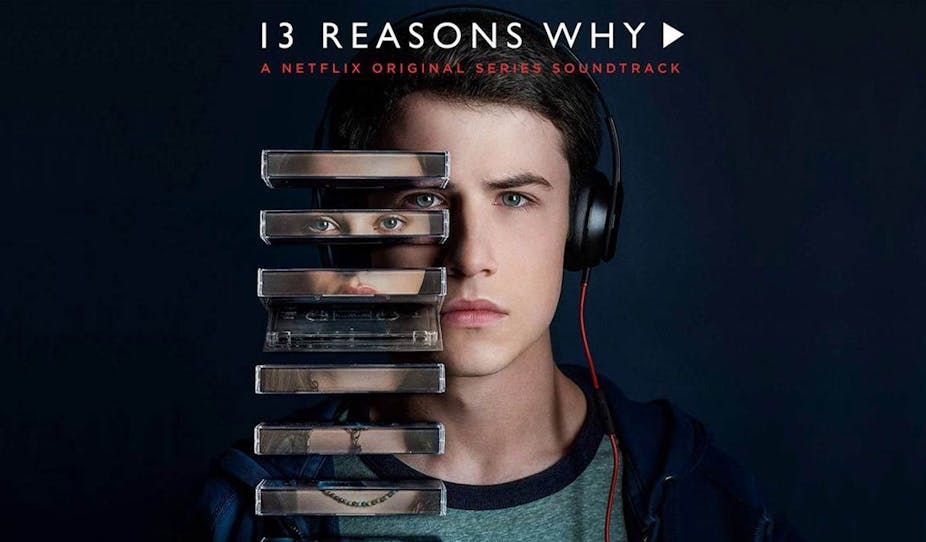13 Reasons Why, the breakout TV series, has gotten people talking since it first aired on Netflix on March 31, 2017. Three scenes brutally – some will say realistically – depict the rape of two characters and the suicide of one, Hannah Baker. Many mental-health specialists have condemned the show for glorifying suicide (Hannah gets back post-mortem at the people who hurt her). They consider that some twist plots, as well as the lack of resources readily available to people watching the show, may affect already-vulnerable viewers. Others, such as writer Brian Yorkey, defend the show as a sensitive depiction of suicide and the damage it can cause.
But if one can suspend judgement of the three scenes, what remains is the show’s very real depiction of gender violence and sexual harassment in school.
Slut shaming and female sexuality
Based on a novel by Jay Asher, 13 Reasons Why follows high school student Clay Jensen as he listens to audio recordings made by his friend Hannah Baker prior to her death. Hannah narrates the events leading to her suicide, and posthumously identifies the people who failed her, be it by hurting her, cutting ties with her, or not providing help when she most needed it.
13 Reasons Why accurately illustrates the struggles teenage girls go through, especially when it comes to sexuality. The main female characters all have to face some form of “slut shaming”. The term refers to the practises and attitudes through which girls are blamed for not conforming to sexual standards. Hannah, for example, is humiliated and intimidated because of rumours concerning her supposed sexual promiscuity – that she’d had sex in a public space and kissed a girl. These rumours are based on questionable facts and disseminated on cell phones. Jessica and Courtney also fear having their reputation tarnished due to gossip concerning their sexuality. Only Sheri and Skye, secondary characters, seem to get by without too much damage.
Slut shaming and gender-based violence are as much about power dynamics and popularity as they are about sex, and 13 Reasons Why brilliantly illustrates this point. For example, it is to gain accolades from his friends that Justin claims that he had sex with Hannah. Social hierarchy is also the reason that a list ranking girls’ “attributes” circulates (Hannah’s name figures as “best ass”). And it is the reason that Courtney, to preserve her reputation, withdraws from Hannah after a picture of their kiss is sent out to everyone.

The show directly addresses the confusion that may sometimes surround the notion of consent. In a scene that’s particularly difficult to watch, Hannah meets with Mr. Porter, the school counsellor, and tries to talk about having been raped. He suggests to her that, if she did not explicitly say no or tell her aggressor to stop, she most likely consented to having sex with him. 13 Reasons Why presents rape as something that that works hand-in-hand with power dynamics, and that permeates the school’s entire climate. It is because the rumours about Hannah’s sexuality are false – she did not in fact have sex in a public park, nor did she seek out a lesbian kiss – that we, as spectators, can feel empathy towards her. How much empathy would we have felt if the rumours had been true? – if she had actively sought out these encounters and/or taken pleasure from them? Would she then have deserved to be slut-shamed?
Flexible masculinities
The show presents conceptions of masculinity that are more nuanced than those usually shown on television, especially in shows targeting teenagers. It also includes positive representations of young gay men – Tony and Ryan are light years away from the “tragic victim"–like non-heterosexual tropes. And although the majority of the male characters find their motivation in the possibility of falling in love or having sex (Clay, Bryce, Justin, Marcus and Zach are all examples of that), 13 Reasons Why also allows for teenagers who aren’t interested in such things. School photographer Tyler, Tony and Ryan, and to a certain extent, Alex, have other reasons pushing them to action.

13 Reasons Why consistently upsets the viewers’ references when it comes to masculinity, in a genre (teen television) that is not usually known for being innovative, with the possible exception of Glee. Clay Jensen, 13’s main character, is a good guy and friendly with all students. He nevertheless is shown with scars on his face for the entire 13 episodes – the result of a bike accident and fistfights – and is incapable of opening up to his parents. Clay and Tony personify a masculinity that is nurturing and caring. Even Justin and Bryce, the show’s "bad boys”, sports stars and popular students, do not fully respect the codes of traditional hegemonic masculinity. Justin is often seen crying, and in a tragic scene, he evens fails at protecting his girlfriend from being sexually assaulted. Bryce is shown offering support to his friends (for example, by letting one of them living at his house for many days on end).
Gendered lessons of the show
All in all, 13 Reasons Why only shows teenagers doing exactly what they’ve been taught to do. It tells us that the gender models they’re being offered remain extremely restrictive and damaging. That dominant masculinities still play a role in how young men interact with their peers. That girls are expected to be desirable and attractive, yet not play an active role in their own sexuality. That those who do not comply with these gender rules will be severely punished.
In this sense, the show allows for numerous demonstrations of the strength, and the inevitability, through which gender socialization plays out. “Nothing anyone did to Hannah was any different than was happens to every girl at every high school”, says Marcus towards the end of the show. Isn’t that, in itself, one of the most upsetting aspects of the show?


